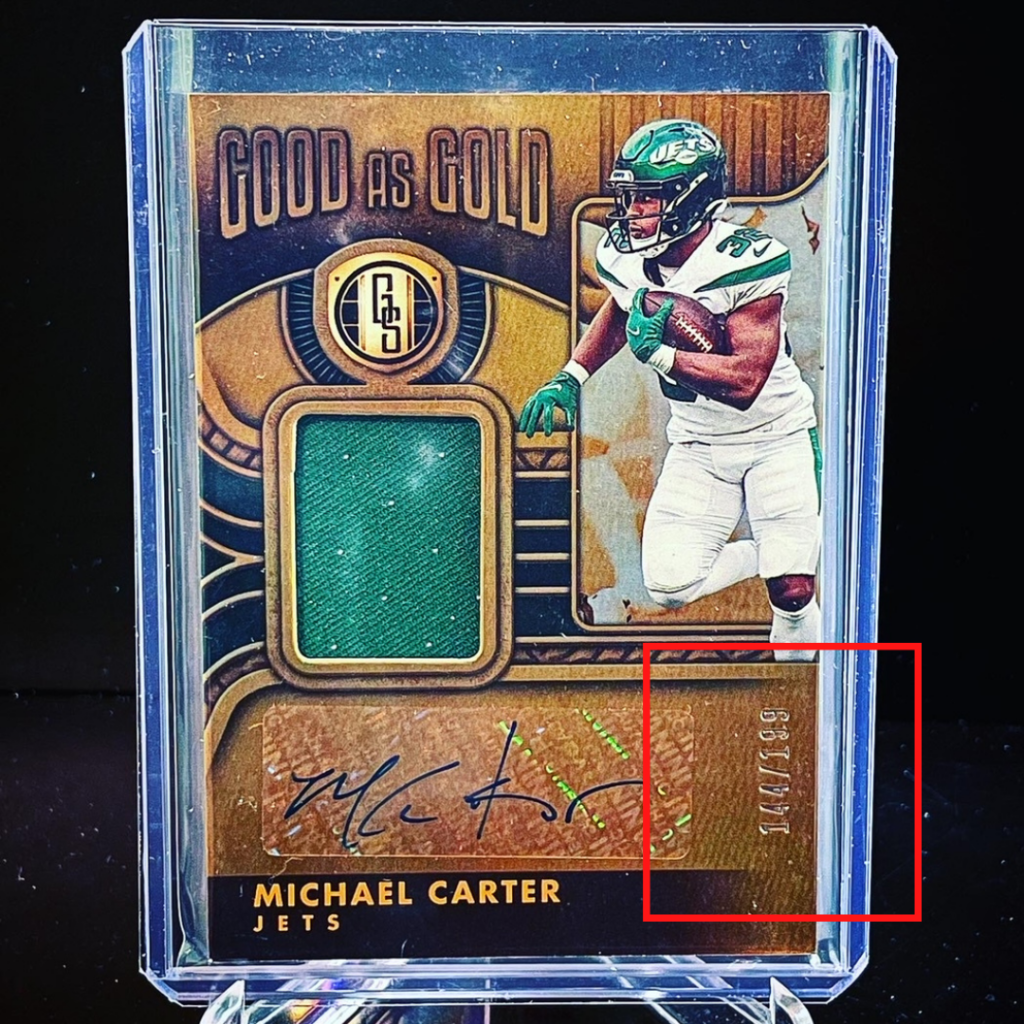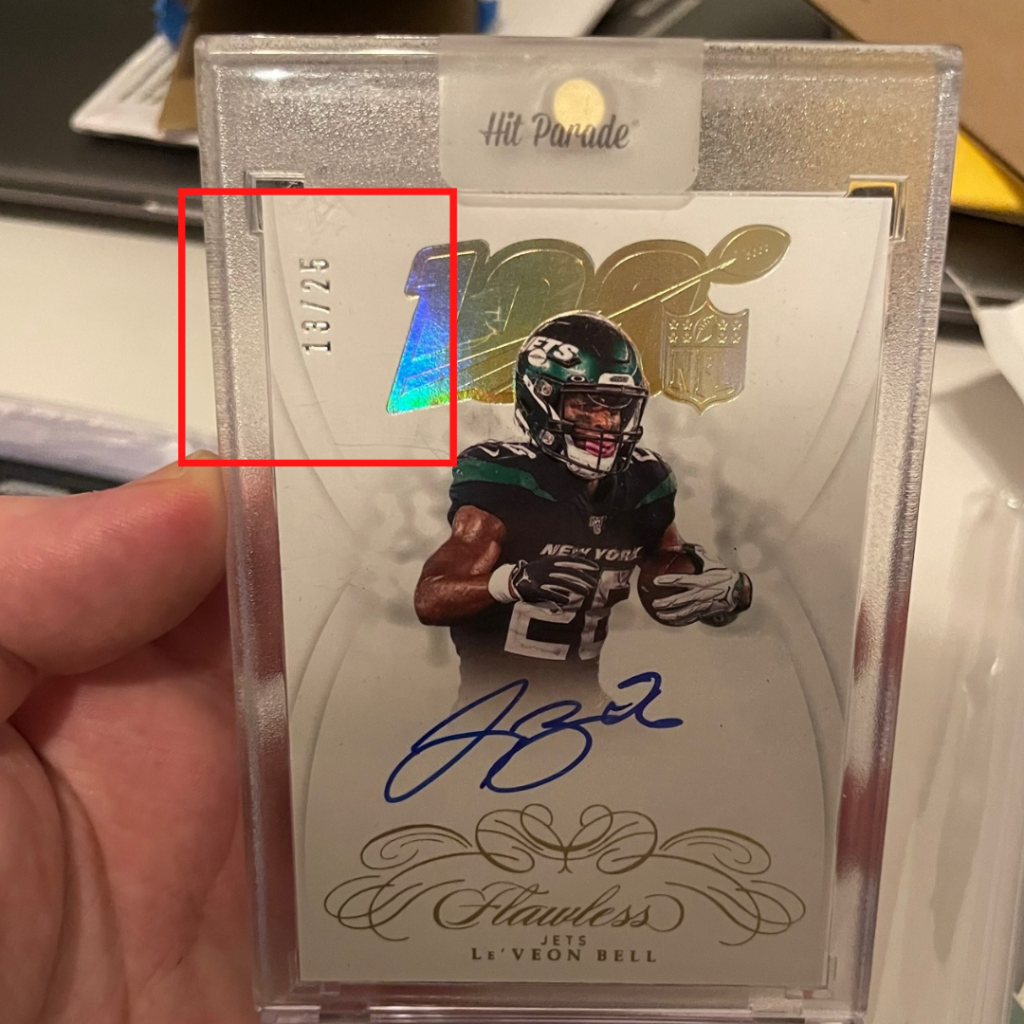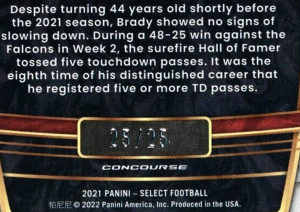We answer the critical questions about why low numbered sports cards are valuable, what makes them valuable and what the serial number means.
In addition, our guide goes in-depth on where you can find serial numbers on a card, how they work, and what to expect or look for when adding them to your collection.
We explain why different serial numbers make them more expensive or less valuable. For example, for cards with serial numbers 364/399 or 1/25, why is the first less expensive than the second? In addition, you’ll learn about ‘short’ and ‘long’ prints and why the print run matters.
Let’s start with the basics:
What Are Numbered Sports Cards?
Each trading card has a serial number and a unique identification number assigned accordingly. Cards have a serial number which helps you identify which print version you own and if the total amount of prints is high or low. For example, when there are sports trading cards with only five prints, it’s more valuable compared to one with 399 prints.
The value of a sports trading card serial number comes down to print scarcity. First, one-digit serial numbers are the rarest because there are only five; next is a two-digit serial, with only thirty; three-digit has only three hundred; and so on.
Can Two Cards Have the Same Number?
No two cards are the same when they have a serial number; each number will only have one number associated with it, like 1/25 or 2/25; there’s only one of each.
While cards that do not have a serial number will have a number associated with the card, like Cole Beasley Prestige 2021 Panini Number 15, this card does not have a serial number, so there could be thousands of prints of this card.
A common reason sports trading cards have serial numbers is that they help with the authenticity or provenance of a particular item.
Where Can You Find the Serial Number on a Card?

You’ll usually find a serial number on the back of the sports trading card. It’ll either be in the top right corner or the bottom right corner. However, brands like Obsidian, Gold Standard or Topps Chrome print their serial numbers on the front of the card.
When you first look at a card you are interested in adding to your collection, see if it has a serial number and which number it’s out of to determine if it’s a ‘short’ print or a ‘long’ print.
Sometimes you can get a great deal by keeping an eye out for those when others need to become more familiar with how the numbers work.
What Do the Numbers Mean on the Back of a Football Card?
In addition to the serial number, the back of a football trading card may also include other information about the player, such as their position, team, college, or hometown. Some cards may also include biographical information or career highlights.
- Touchdown number: The number of touchdowns (six points) scored by a player.
- Rushing yards number: The number of yards a player gains on rushing plays.
- Receiving yards number: The number of yards a player gains on receptions.
- Tackles number: The number of tackles (in which a player brings down an opposing player with the ball) made by a player.
- Interceptions number: The number of interceptions (passes caught by a player on defense) made by a player.
- Sacks numbers: The number of sacks (tackles in which a player brings down the quarterback behind the line of scrimmage) made by a player.
Are Low-Numbered Sports Cards Valuable?

Low serial number sports cards tend to sell for more and are more expensive due to their rarity. It’s mainly due to the print run; for example, if it’s been ‘short-printed, then it tends to be less than 45 prints, or if it’s been ‘long’ printed, it tends to be greater than 100, like 399, for example.
When looking to buy or sell trading cards, you want a ‘short’ print card like 25 or less and a low number like 1/25 or 1/4.
Here are a couple of examples where valuable serial numbers exist:
- The first print or a serial number less than 2
- The last print or serial number like 399/399 or 25/25
Here are a couple of examples where less valuable serial numbers exist:
- Within the last ten prints or serial numbers like 392/399 or 396/399
- Within the middle of the prints or serial numbers like 206/399.
- The reason for this to be less valuable is primarily due to how it’s not a print that’s earlier in the production run. If it was below 100, like 64/399, it’s more valuable because it’s within the top 100.
Are Numbered Sports Cards Worth More?
There are many situations where a card does not have a serial number, which reduces the card’s overall value. However, you’ll want cards with a serial number, as this helps you identify the following:
1. How much is the card worth? Is the card short-printed or not? Typically, when they do not have a serial number, the card has been printed more than 1000 times, decreasing the overall value.
2. Which print ran first? The serial number shows the order of prints for a particular card; for example, 1/25 came before 2/25. It would give you a good sense, especially if there were an error card. You can identify if the card was a part of it or not.
How Do You Find Sports Card Prices for Low Numbered
What Does 1 of 1 Mean on Sports Cards?
1 of 1 – Only one exists. 1/1s attract a lot of attention, and if you buy them on eBay, there can be anywhere from 30 to 96 watchers on those listings.
The majority of 1/1 sports cards are of legends and include their autograph or jersey patch from game-worn moments. In addition, brands like Panini, Flawless, National Treasures, and Spectra all have 1-of-1 sports trading cards.
You’ll find a great example of wax that offers 1-of-1s, including the ‘2021 Panini One Football Hobby Box. Typically, a box of this can cost anywhere between $450 to $520 in a soft market, and the wax only comes with one card.
If you were to pull a player who hasn’t been performing well in their career or is no longer playing, you could lose nearly 80% to 90% of the cost in value.
Always consider the risks before opening a 1 card wax box because they tend to increase in value having them sealed than opened.
Examples of Sports Card Serial Numbers (Ranges)
- 1/25 – Only 25 exist, and it ran at most twenty-five times.
- 1/30 – Only 30 exist, and it ran to thirty times.
- 1/54 – Only 54 exist, and it ran to Fifth-Five times.
- 1/399 – Only 399 exist, and it ran at most Three-hundred and Ninety Nine times.
Examples of Most Valuable 1-1 Serial Number

Here are a few examples of the most valuable one-of-one cards across football, baseball, soccer, and basketball:
- LeBron James 2003 Upper Deck One of One rookie card.
- Tom Brady 2000 Pacific Prism One of One autographed card.
- Babe Ruth 1933 Goudey One of One baseball card.
- Mike Trout 2015 Topps One of One Chrome rookie card.
- Michael Jordan 1986 Fleer One of One rookie card.
- Cristiano Ronaldo 2010 Panini One of One autographed soccer card.
- Aaron Judge 2017 Topps One of One rookie card.
- Lionel Messi 2013 Panini One of One autographed soccer card.
- Wayne Gretzky 1979 O-Pee-Chee One of One hockey card.
- Kobe Bryant 1996 SkyBox One of One rookie card.
Why Sports Trading Cards Have Serial Numbers
Remember, the numbers on the back of a card can have multiple meanings and impact the card’s overall value. Here are a few key takeaways to consider:
- Scarcity drives value: Serial numbers help determine the print run and create scarcity. A ‘short’ print is more valuable than a ‘long’ print.
- Only some cards have serial numbers: Look for cards with serial numbers as they are more exclusive; cards with serial numbers could have 1000 prints.
If you’ve enjoyed reading this article, you may also like the following:
525+ subscribers to our weekly newsletter
Get cardboard breaking news sent directly to your inbox, along with tips and buyer guides you won’t want to miss.
Sports card hobby enthusiast (originally from New York) who can’t resist ripping cards and eating donuts on the weekends. Passionate about all collecting, have been collecting football cards and other memorabilia for half a decade. Enjoys going to card shows, visiting card shops and getting to know other collectors. Owner of NOWCollectibles a collectible e-commerce business – online card shop for buying affordable cards helping connect sports fans with their favorite teams and players. Follow my personal IG to see PC: @NowCollects See my latest articles here: NowCollectibles Articles (thinksportscards.com)
